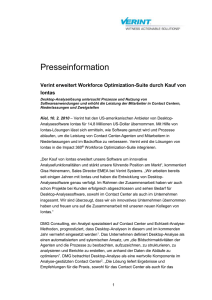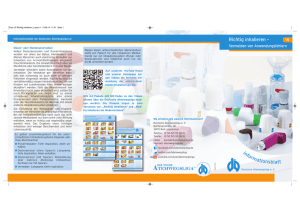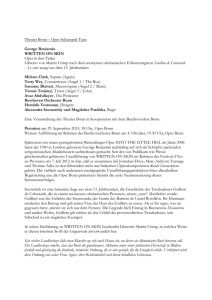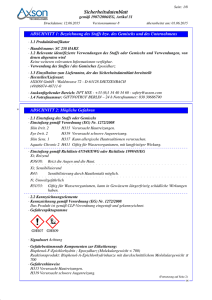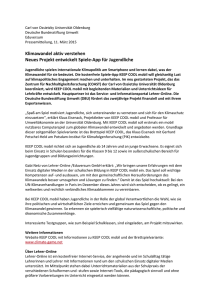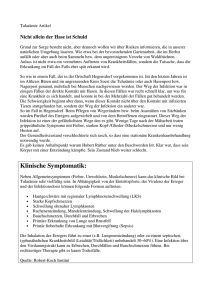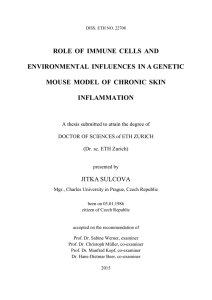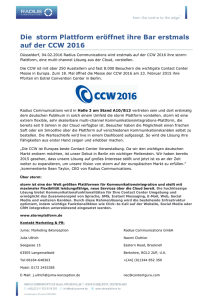Synthese von 3
Werbung
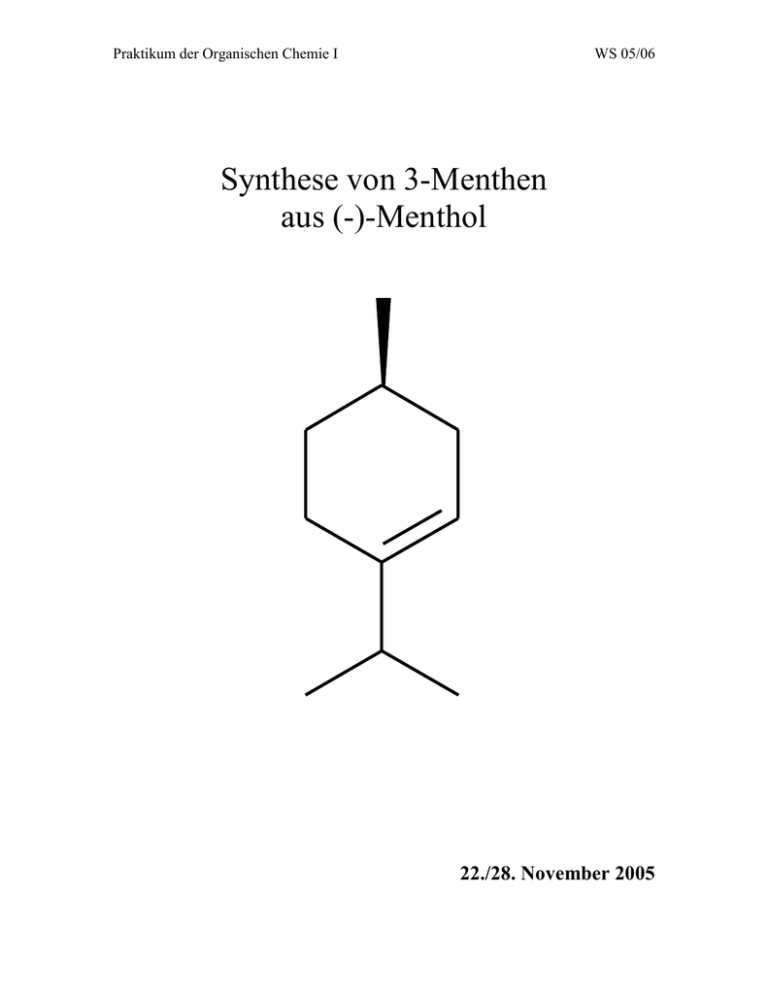
Praktikum der Organischen Chemie I WS 05/06 Synthese von 3-Menthen aus (-)-Menthol 22./28. November 2005 Praktikum der Organischen Chemie I WS 05/06 1. Methode Eliminierung eines Alkohols zum Alken durch katalytische Mengen konzentrierter Schwefelsäure. 2. Reaktionsgleichung kat. H2SO4 OH 65 °C, 1h 3. Mechanismus H+ + OH2 OH + OH2 + + - H + H 2 + H2O Praktikum der Organischen Chemie I WS 05/06 4. Physikalische Daten Substanz (-)-Menthol Schwefelsäure 95-98% H2SO4 98.08 MTBE, Methyl-tertbutylether C5H12O 88.15 Molekularformel Molare Masse [g/mol] Dichte [g/cm3] Schmelzpunk [C°] Siedepunkt [C°] Brechungsindex Wassergiftklasse C10H20O 156.27 41 - 44 216 1 (schwach wassergefährdend) 4 38 25 siehe Anhang 1.84 -15 310 1 0.74 -108.6 55.3 1 35 26-30-45 11-38 9-16-24 Substanz Molekularformel Molare Masse [g/mol] Dichte [g/cm3] Schmelzpunk [C°] Siedepunkt [C°] Brechungsindex Wassergiftklasse Giftklasse CH R- Sätze S- Sätze Bedeutung Magnesiumsulfat MgSO4 120.37 Natriumchlorid NaCl 58.44 3-Menthen C10H18 138.3 2.66 1 22-24/25 siehe Anhang 2.17 801 1461 1 - - Substanz Natriumhydrogencarbonat NaHCO3 84.01 Giftklasse CH R- Sätze S- Sätze Bedeutung Molekularformel Molare Masse [g/mol] Dichte [g/cm3] Schmelzpunk [C°] Siedepunkt [C°] Brechungsindex Wassergiftklasse Giftklasse CH R- Sätze S- Sätze 2.22 270 50 22-24/25 3 Praktikum der Organischen Chemie I WS 05/06 5. Apparatur 6. Ansatz Anzahl Mole [mmol] 33.3 Äquiv. Menge Bemerkungen (-)-Menthol Molgewicht [g/mol] 156.27 1 5.2 g 95-98% H2SO4 98.08 12.5 0.38 0.7 ml Substanz 4 Berechnung der Mole unter der Annahme H2SO4 sei 95%ig. Praktikum der Organischen Chemie I WS 05/06 7. Experimentelle Durchführung Reaktion: In einem Zweihalsrundkolben wurden (-)-Menthol (5.2 g, 33.3 mmol, 1 eq) mit 95-98%iger Schwefelsäure (0.7 ml, 12.5 mmol, 0.38 eq) vermischt. Die Reaktionsmischung wurde während 1 h bei 65 °C gerührt. Der Reaktionsfortschritt wurde mittels Dünnschichtchromatographie (DC) verfolgt. (Dazu wurden der Reaktionslösung nach 25 min mit einer Pasteurpipette winzige Mengen entnommen und mit 0.5 ml ges. wässr. NaHCO3-Lösung neutralisiert. Anschliessend wurde mit 1 ml MTBE durchgespült. Von der organischen Phase wurde eine Probe auf eine DC-Platte getüpfelt. Als Vergleich wurde nebenan das Edukt gelöst in Methylenchlorid aufgetragen. Die DC wurde mit 10% EtOAc in Hexan durchgeführt.) Eine zweite DC-Kontrolle wurde nach 55 Minuten gemacht. Isolierung und Reinigung: Nach 1 h wurde die Reaktion im Eisbad durch Zugabe von ges. wässr. NaHCO3-Lösung gestoppt und auf pH 7 eingestellt. Die Reaktionsmischung wurde in einen Scheidetrichter gespült und mit MTBE (3x 100 ml) extrahiert. Die vereinigten org. Phasen wurden mit ges. wässr. NaCl-Lösung (100 ml) gewaschen, über MgSO4 getrocknet und das Lösungsmittel am Rotationsverdampfer abdestilliert. Der Rückstand wurde über eine Vigreux-Kolonne fraktioniert destilliert, wobei ein Vakuum von 10 mbar angelegt wurde. Das Ölbad wurde auf 170 °C aufgeheizt. Bei einer Dampftemperatur von 83 °C wurde eine Fraktion gesammelt. Laufmittel: EtOAc/Hexan 1 : 9 5 Praktikum der Organischen Chemie I WS 05/06 8. Ausbeute Das gewünschte Produkt konnte nur bei der zweiten DC-Kontrolle nach 55 min. nachgewiesen werden. Eine Angabe der Ausbeute in Prozent ist nicht möglich, da das Produkt nach der Destillation nicht rein erhalten wurde. 9. Charakterisierung a) Schmelzpunktbestimmung Der Schmelzpunkt des erhaltenen Produktes liegt unterhalb von 40 °C. Schon beim Füllen der Schmelzpunktbestimmungskapillare wurde die feste Substanz durch Berührung (Einfluss von Körpertemperatur) leicht flüssig, wodurch diese nicht mehr in die Kapillare gelangte. b) Infrarot-Spektrum Es wurden zwei IR-Spektren aufgenommen. Eines mit der einzigen erhaltenen Fraktion (1) der Destillation und ein zweites mit dem Rückstand (2). Da beide Spektren einander sehr ähnlich sind, wird hier nur (1) interpretiert. IR-Spektrum der Destillationsfraktion (1): Banden [cm-1] 3278 2952, 2919, 2868 1454 Interpretation O-H, Alkoholgruppe C(sp3)-H, Alkylgruppen C(sp3)-H, Alkylgruppen 10. Bemerkungen und Diskussion Die zweite DC-Kontrolle bestätigte, dass das Edukt nach 55 Minuten zu einem Teil umgesetzt wurde. Das IR-Spektrum zeigt, dass nur nicht umgesetztes Startmaterial ((-)-Menthol) rückisoliert wurde. Ein mögliches Signal der C=C-Bindung von 3-Menthen bei 1620-1680 cm-1 ist in keinem Spektrum zu erkennen. Der Schmelzpunkt unter 40 °C deutet darauf hin, dass nicht nur das (-)-Menthol in der Destillationsfraktion vorhanden ist. Dieses hätte einen Schmelzpunkt von 41-44 °C. Verunreinigungen setzen den Schmelzpunkt um einige °C herab. Vielleicht handelt es sich hier gerade um die kleine Menge an 3-Menthen. 6 Praktikum der Organischen Chemie I WS 05/06 Literatur [1] www.fluka.com [2] http://ch.chemdat.info/ [3] Keese Reinhardt, Grundoperationen der präparativen organischen Chemie, 2003, Druckerei Glauser AG, Bern Anhang Risk Phrases Indication of Particular Risks R1: Explosive when dry 33: Danger of cumulative effects 34: Causes burns 35: Causes severe burns 2: Risk of explosion by shock, friction, fire or other sources of ignition 3: Extreme risk of explosion by shock, friction, fire or other sources of ignition 4: Forms very sensitive explosive metallic compounds 5: Heating may cause an explosion 6: Explosive with or without contact with air 7: May cause fire 8: Contact with combustible material may cause fire 9: Explosive when mixed with combustible material 10: Flammable 36: Irritating to the eyes 37: Irritating to the respiratory system 38: Irritating to the skin 39: Danger of very serious irreversible effects 40: Possible risk of irreversible effects 41: Risk of serious damage to eyes 42: May cause sensitization by inhalation 43: May cause sensitization by skin contact 44: Risk of explosion if heated under confinement 45: May cause cancer 46: May cause heritable genetic damage 48: Danger of serious damage to health by prolonged exposure 49: May cause cancer by inhalation 11: Highly Flammable 12: Extremely Flammable 14: Reacts violently with water 15: Contact with water liberates extremely flammable gases 16: Explosive when mixed with oxidizing substances 17: Spontaneously flammable in air 18: In use may form flammable/explosive vapor-air mixture 19: May form explosive peroxides 50: Very Toxic to aquatic organisms 51: Toxic to aquatic organisms 52: Harmful to aquatic organisms 7 Praktikum der Organischen Chemie I WS 05/06 20: Harmful by inhalation 53: May cause long-term adverse effects in the aquatic environment 54: Toxic to flora 55: Toxic to fauna 56: Toxic to soil organisms 57: Toxic to bees 58: May cause long-term adverse effects in the environment 59: Dangerous for the ozone layer 60: May impair fertility 61: May cause harm to the unborn child 62: Possible risk of impaired fertility 21: Harmful in contact with skin 22: Harmful if swallowed 23: Toxic by inhalation 24: Toxic in contact with skin 25: Toxic if swallowed 26: Very Toxic by inhalation 27: Very Toxic in contact with skin 28: Very Toxic if swallowed 29: Contact with water liberates toxic gas 30: Can become highly flammable in use 63: Possible risk of harm to the unborn child 64: May cause harm to breast-fed babies 65: Harmful: May cause lung damage if swallowed 31: Contact with acids liberates toxic gas 32: Contact with acids liberates very toxic gas Risk Phrases Combination of Particular Risks 39/28:Very Toxic: danger of very serious irreversible effects if swallowed R14/15:Reacts violently with water, liberating extremely flammable gases 15/29:Contact with water liberates toxic, extremely flammable gas 40/20:Harmful: possible risk of irreversible effects through inhalation 40/20/Harmful: possible risk of irreversible 21:effects through inhalation and in contact with skin 40/20/Harmful: possible risk of irreversible 21/22:effects through inhalation, in contact with skin and if swallowed 40/20/Harmful: possible risk of irreversible 22:effects through inhalation and if swallowed 40/22:Harmful: possible risk of irreversible effects if swallowed 40/21:Harmful: possible risk of irreversible effects in contact with skin 40/21/Harmful: possible risk of irreversible 22:effects in contact with skin and if swallowed 42/43:May cause sensitization by inhalation and skin contact 20/21:Harmful by inhalation and in contact with skin 20/21/2Harmful by inhalation, in contact 2:with skin and if swallowed 20/22:Harmful by inhalation and if swallowed 21/22:Harmful in contact with skin and if swallowed 23/24:Toxic by inhalation and in contact with skin 23/24/2Toxic by inhalation, in contact with 5:skin and if swallowed 8 Praktikum der Organischen Chemie I WS 05/06 23/25:Toxic by inhalation and if swallowed 48/20:Harmful: danger of serious damage to health by prolonged exposure through inhalation 48/20/Harmful: danger of serious damage 21:to health by prolonged exposure through inhalation and in contact with skin 48/20/Harmful: danger of serious damage 21/22:to health by prolonged exposure through inhalation, and in contact with skin and if swallowed 48/20/Harmful: danger of serious damage 22:to health by prolonged exposure through inhalation and if swallowed 48/21:Harmful: danger of serious damage to health by prolonged exposure in contact with skin 48/21/Harmful: danger of serious damage 22:to health by prolonged exposure in contact with skin and if swallowed 48/22:Harmful: danger of serious damage to health by prolonged exposure if swallowed 48/23:Toxic: danger of serious damage to health by prolonged exposure through inhalation 48/23/Toxic: danger of serious damage to 24:health by prolonged exposure through inhalation and in contact with skin 48/23/Toxic: danger of serious damage to 24/25:health by prolonged exposure through inhalation, in contact with skin and if swallowed 48/23/Toxic: danger of serious damage to 25:health by prolonged exposure through inhalation and if swallowed 48/24:Toxic: danger of serious damage to health by prolonged exposure in contact with skin 48/24/Toxic: danger of serious damage to 25:health by prolonged exposure in contact with skin and if swallowed 24/25:Toxic in contact with skin and if swallowed 26/27:Very Toxic by inhalation and in contact with skin 26/27/2Very Toxic by inhalation, in contact 8:with skin and if swallowed 26/28:Very Toxic by inhalation and if swallowed 27/28:Very Toxic in contact with skin and if swallowed 36/37:Irritating to eyes and respiratory system 36/37/3Irritating to eyes, respiratory system 8:and skin 36/38:Irritating to eyes and skin 37/38:Irritating to respiratory system and skin 39/23:Toxic: danger of very serious irreversible effects through inhalation 39/23/2Toxic: danger of very serious 4:irreversible effects through inhalation in contact with skin 39/23/Toxic: danger of very serious 24/25:irreversible effects through inhalation, in contact with skin and if swallowed 9 Praktikum der Organischen Chemie I 39/23/2Toxic: danger of very serious 5:irreversible effects through inhalation and if swallowed 39/24:Toxic: danger of very serious irreversible effects in contact with skin 39/24/2Toxic: danger of very serious 5:irreversible effects in contact with skin and if swallowed 39/25:Toxic: danger of very serious irreversible effects if swallowed WS 05/06 48/25:Toxic: danger of serious damage to health by prolonged exposure if swallowed 50/53:Very Toxic to aquatic organisms, may cause long-term adverse effects in the aquatic environment 51/53:Toxic to aquatic organisms, may cause long-term adverse effects in the aquatic environment 52/53:Harmful to aquatic organisms, may cause long-term adverse effects in the aquatic environment 39/26:Very Toxic: danger of very serious irreversible effects through inhalation 39/26/2Very Toxic: danger of very serious 7:irreversible effects through inhalation and in contact with skin 39/26/Very Toxic: danger of very serious 27/28:irreversible effects through inhalation, in contact with skin and if swallowed 39/26/2Very Toxic: danger of very serious 8:irreversible effects through inhalation and if swallowed 39/27:Very Toxic: danger of very serious irreversible effects in contact with skin 39/27/2Very Toxic: danger of very serious 8:irreversible effects in contact with skin and if swallowed Safety Phrases Indication of Safety Precautions S1:Keep locked up 2:Keep out of reach of children 3:Keep in a cool place 36:Wear suitable protective clothing 37:Wear suitable gloves 38:In case of insufficient ventilation, wear suitable respiratory equipment 39:Wear eye/face protection 40:To clean the floor and all objects contaminated by this material use ... (to be specified by the manufacturer) 4:Keep away from living quarters 5:Keep contents under ... (appropriate liquid to be specified by the manufacturer) 10 Praktikum der Organischen Chemie I WS 05/06 6:Keep under ... (inert gas to be specified by the manufacturer) 7:Keep container tightly closed 41:In case of fire and/or explosion do not breathe fumes 42:During fumigation/spraying wear suitable respiratory equipment (appropriate wording to be specified) 43:In case of fire, use ... (indicate in the space the precise type of fire-fighting equipment. If water increases the risk add - Never use water) 45:In case of accident or if you feel unwell, seek medical advice immediately (show label where possible) 46:If swallowed, seek medical advice immediately and show this container or label 47:Keep at temperature not exceeding ... E C (to be specified by the manufacturer) 48:Keep wetted with ... (appropriate material to be specified by the manufacturer) 49:Keep only in the original container 50:Do not mix with ... (to be specified by the manufacturer) 51:Use only in well-ventilated areas 52:Not recommended for interior use on large surface areas 53:Avoid exposure - obtain special instruction before use 56:Dispose of the material and its container to hazardous or special waste collection point 57:Use appropriate containment to avoid environmental contamination 59:Refer to manufacturer/supplier for information on recovery/recycling 8:Keep container dry 9:Keep container in a well-ventilated place 12:Do not keep the container sealed 13:Keep away from food, drink and animal feeding stuffs 14:Keep away from ... (incompatible materials to be indicated by the manufacturer) 15:Keep away from heat 16:Keep away from sources of ignition No smoking 17:Keep away from combustible material 18:Handle and open container with care 20:When using, do not eat or drink 21:When using, do not smoke 22:Do not breathe dust 23:Do not breathe gas/fumes/vapor/spray (appropriate wording to be specified by the manufacturer) 24:Avoid contact with the skin 60:This material and/or its container must be disposed of as hazardous waste 61:Avoid release to the environment. Refer to special instructions safety data sheet 62:If swallowed, do not induce vomiting: seek medical advice immediately and show this container or label 25:Avoid contact with the eyes 26:In case of contact with eyes, rinse immediately with plenty of water and seek medical advice 11 Praktikum der Organischen Chemie I WS 05/06 27:Take off immediately all contaminated clothing 28:After contact with skin, wash immediately with plenty of ... (to be specified by the manufacturer) 29:Do not empty into drains 30:Never add water to this product Take precautionary measures against 33: static discharges This material and its container must be 35: disposed of in a safe way Safety Phrases Combination of Safety Precautions S1/2:Keep locked up and out of the reach of children 3/9/14:Keep in a cool well-ventilated place away from ... (incompatible materials to be indicated by manufacturer) 3/9/Keep only in the original container 14/49:in a cool well-ventilated place away from ... (incompatible materials to be indicated by manufacturer) 3/9/49:Keep only in the original container in a cool well-ventilated place 3/14:Keep in a cool place away from ... (incompatible materials to be indicated by the manufacturer) 3/7:Keep container tightly closed in a cool place 7/8:Keep container tightly closed and dry 7/9:Keep container tightly closed and in a well-ventilated place 20/21:When using, do not eat, drink or smoke 24/25:Avoid contact with skin and eyes 29/56:Do not empty into drains, dispose of this material and its container to hazardous or special waste-collection point 36/37:Wear suitable protective clothing and gloves 36/37/3Wear suitable protective clothing, gloves and 9:eye/face protection 36/39:Wear suitable protective clothing and eye/face protection 37/39:Wear suitable gloves and eye/face protection 47/49:Keep only in the original container at temperature not exceeding ... E C (to be specified by manufacturer) 7/47:Keep container tightly closed and at a temperature not exceeding ... E C (to be specified by manufacturer) 12
